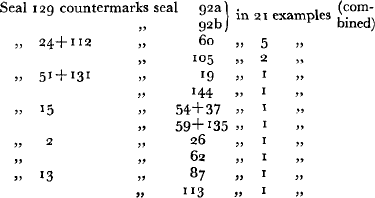Article contents
The cretulae and the Linear A accounting system
Published online by Cambridge University Press: 04 October 2013
Extract
Cretulae is the name given in this article to the small clay nodules, stamped with one or more seal impressions, that have been found in quantity at most Bronze Age sites in the Near East. The Minoan examples are generally smaller than those found at other sites, and the great majority of them have a hole through which string once passed. That is to say, they are lumps of clay squeezed round string and then sealed. At most of the sites in Crete where they are known, they have been found in conjunction with inscribed clay tablets and clay disks. At Hagia Triada they are unique in being for the most part countermarked with a sign of the Linear A script. The interrelationships of the countermarks and sealings have not previously been recorded, and it is the primary purpose of this article to publish them. The catalogue will be found in Appendix A. Proper analysis of it should shed light on Minoan methods of administration, and perhaps too on the purpose of the Linear A tablets. That the tablets, or some of them, belong to a coherent system of administration, and are not all mere inventory lists of what happened to be coming into or going out of store at a particular moment, seems guaranteed by the fact, to which I shall revert later, that totals in the same numerical proportion are found at widely distant sites.
- Type
- Research Article
- Information
- Copyright
- Copyright © The Council, British School at Athens 1960
References
1 From the artistic point of view the Hagia Triada cretulae have been published in full by Levi, , Annuario viii–ix. 71 sq.Google Scholar Similarly the Zakro cretulae (ibid. 157 sq. and Hogarth, JHS xxii. 76 sq.Google Scholar; BSA xvii. 264). Linear A inscriptions are referred to as numbered in Pugliese Carratelli's edition in Monumenti Antichi xl, and the signs are identified by his L numeration.
2 In his lecture in 1902 Halbherr referred to five tablets, five clay disks, and over 400 cretulae as having been discovered in the north-west portico. These were published the next year (Mon. Ant. xiii. 33 ff.). In 1903 Parabeni, (Rend. Ace. Linc. 330)Google Scholar says that eleven tablets, ten disks, and 864 sealings were found in the same area in two years of excavation. These tablets must be Carratelli's HT 1–5 (first year), HT 6–11 (second year). The clay disks published by Levi in 1926 number eighteen; the discrepancy of eight disks is presumably accounted for by some of the smaller disks having been previously counted with the cretulae.
3 Carratelli, , Mon. Ant. xl. 132Google Scholar, though I failed to find a reference to these cretulae in the published sources. These are usefully listed by Carratelli at the end of this chapter.
4 The cretula types given in Halbherr's article in Mon. Ant. xiii (asterisked in the catalogue in Appendix A) were found in the north-west portico. Eut since the article only deals with the first year's excavation, there is no way to tell between the other 400 from the north-west portico and the large number from the gypsum chest.
5 Parabeni, loc. cit. 323, says that none are counter-marked.
6 See Appendix B. The disk-type cretulae differ from the normal in two respects, first that they are inscribed on more than one side, and secondly that their inscriptions are clearly of the same purport as the inscriptions on the disks. There is, curiously, a parallel in the Hieroglyphic Deposit at Knossos. Here the one cretula which is not stamped with a seal impression seems to have performed the function of a label, as it is also the only cretula to bear a word common to the labels (SM i. 165, P 76; cf. P 93a, P 108a).
7 Compiled from Hogarth and Levi. The details are:
![]()

8 Among the sealings of type 125 there are four different hands responsible for the L 100 series of countermarks; for the L 100+L 58 series there are three hands responsible, two of them different from those in the first-mentioned group. See also the forms of L 92 and of L 98 in Appendix A. Where the letters are nearly all solo occurrences on separate objects it is clearly impossible to fix a maximum of scribes.
9 Seidl in Legacy of Egypt 203.
10 The only evidence that suggests that the function of the cretulae was to seal correspondence is the discovery by Marinatos, (AE 1939–1941, 87 ff.)Google Scholar at Sklavokampo of nodules bearing the same seal-impressions as have been found elsewhere; notably for our purpose Levi seal 117—a countermarker—at Hagia Triada equals Marinates seal 8 at Sklavokampo. (To judge from the illustrations given, the charging bull (Marinatos 2) does not seem the same as the Hagia Triada seal he quotes (Levi 54)). The Zakro sealings from Anemomylia near Knossos bought by Evans, (PM ii. 254)Google Scholar are suspect evidence, since excavation failed to reveal any more. Mr. Kenna, to whom I am grateful for the care with which he has examined them, tells me they do not look like forgeries. But since there seems no warrant for Evans's remarks about the peculiar nature of the clay, it cannot be excluded that they may have been genuine Zakro sealings extracted from the original find, especially as they are among the most frequent of the Zakro combinations.
11 The catalogue was drawn up at Heraklion in 1957, and I must thank the Director of the Museum, Dr. Platon, not only for allowing me to work on the material but also for his consistent helpfulness while I was doing so. I have deposited with him a detailed index of the cretulae for the convenience of any future worker who wishes to check my figures and allocations.
- 1
- Cited by




